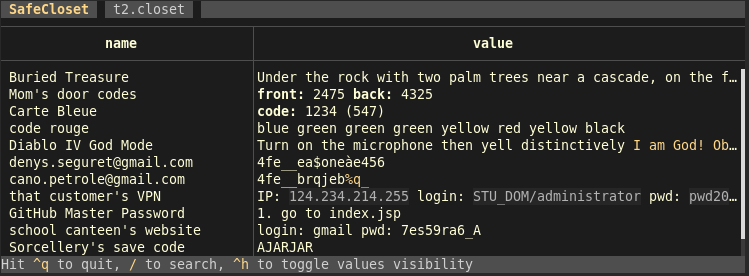SafeCloset keeps your secrets in password protected files. SafeCloset is designed to be convenient and avoid common weaknesses like external editing or temporary files written on disk.
A closet is stored in a file that you can backup, keep with you on an USB key, etc. A closet contains drawers, each one is found and open with its own password. A drawer contains a list of (key, value). Values are texts in which you can store a code, a password, comments, a poem, some data, etc. A drawer can also contain deeper crypted drawers.
This is free and open source software.
Features include:
- The closet contains several drawers, some of them automatically created with an unknown password so that nobody can determine which drawers you’re able to open, or even how many.
- Each drawer is separately crypted with AES-GCM-SIV, with a random one-use nonce and the password/key of your choice. This gives an inherently long to test decrypt algorithm (but you should still use long passphrases for your drawers).
- You can have one or several drawers with real content. You can be forced to open a drawer and still keep other drawers secret without any trace, either at the top level or deeper in the drawer you opened.
- When you open a drawer, with its password, you can read it, search it, edit it, close it.
- In an open drawer you can create new drawers, or open deeper drawers if you know their password.
- Automatically quits on inactivity.
- The size of the drawer’s content isn’t observable.
- No clear file is ever created, edition is done directly in the TUI (external editors are usually the weakest point).
- No clear data is ever given to any external library, widget, etc.
- All data is viewed and edited in the TUI application.
- You can compile SafeCloset yourself. Its code is small and auditable.
- The format of the closet file is described so that another application could be written to decode your closet files in the future (assuming you have the password).
- SafeCloset can’t be queried by other applications, like browsers. This is a feature.
- You may have all your secrets in one file easy to keep with you and backup.
- No company can die and lose your secrets: you keep everything, with as many copies as necessary, where you want.
- No company can be forced to add some secret stealing code: SafeCloset is small, open-source and replaceable.
- Fast and convenient to use.
- Cross-platform support.
- “I’m being watched” mode in which unselected values are hidden. This mode is kept per drawer, always activated when you launch SafeCloset with the
--hideoption, and toggled withctrl-h.
Website: github.com/Canop/safecloset
Support:
Developer: Denys Séguret
License: GNU Affero General Public License v3.0

SafeCloset is written in Rust. Learn Rust with our recommended free books and free tutorials
| Popular series | |
|---|---|
| The largest compilation of the best free and open source software in the universe. Each article is supplied with a legendary ratings chart helping you to make informed decisions. | |
| Hundreds of in-depth reviews offering our unbiased and expert opinion on software. We offer helpful and impartial information. | |
| The Big List of Active Linux Distros is a large compilation of actively developed Linux distributions. | |
| Replace proprietary software with open source alternatives: Google, Microsoft, Apple, Adobe, IBM, Autodesk, Oracle, Atlassian, Corel, Cisco, Intuit, SAS, Progress, Salesforce, and Citrix | |
| Awesome Free Linux Games Tools showcases a series of tools that making gaming on Linux a more pleasurable experience. This is a new series. | |
| Machine Learning explores practical applications of machine learning and deep learning from a Linux perspective. We've written reviews of more than 40 self-hosted apps. All are free and open source. | |
| New to Linux? Read our Linux for Starters series. We start right at the basics and teach you everything you need to know to get started with Linux. | |
| Alternatives to popular CLI tools showcases essential tools that are modern replacements for core Linux utilities. | |
| Essential Linux system tools focuses on small, indispensable utilities, useful for system administrators as well as regular users. | |
| Linux utilities to maximise your productivity. Small, indispensable tools, useful for anyone running a Linux machine. | |
| Surveys popular streaming services from a Linux perspective: Amazon Music Unlimited, Myuzi, Spotify, Deezer, Tidal. | |
| Saving Money with Linux looks at how you can reduce your energy bills running Linux. | |
| Home computers became commonplace in the 1980s. Emulate home computers including the Commodore 64, Amiga, Atari ST, ZX81, Amstrad CPC, and ZX Spectrum. | |
| Now and Then examines how promising open source software fared over the years. It can be a bumpy ride. | |
| Linux at Home looks at a range of home activities where Linux can play its part, making the most of our time at home, keeping active and engaged. | |
| Linux Candy reveals the lighter side of Linux. Have some fun and escape from the daily drudgery. | |
| Getting Started with Docker helps you master Docker, a set of platform as a service products that delivers software in packages called containers. | |
| Best Free Android Apps. We showcase free Android apps that are definitely worth downloading. There's a strict eligibility criteria for inclusion in this series. | |
| These best free books accelerate your learning of every programming language. Learn a new language today! | |
| These free tutorials offer the perfect tonic to our free programming books series. | |
| Linux Around The World showcases usergroups that are relevant to Linux enthusiasts. Great ways to meet up with fellow enthusiasts. | |
| Stars and Stripes is an occasional series looking at the impact of Linux in the USA. | |
